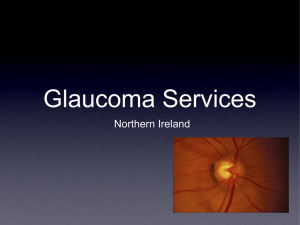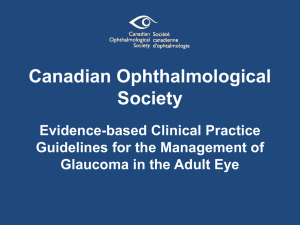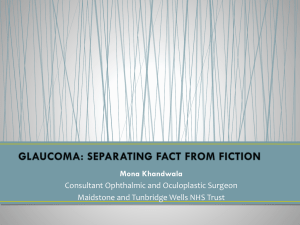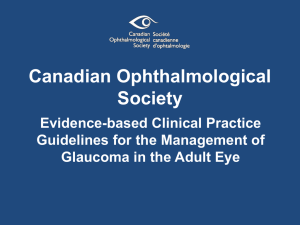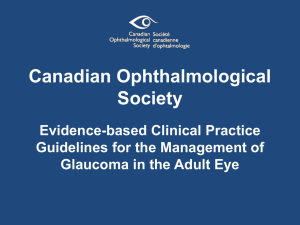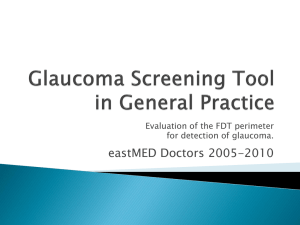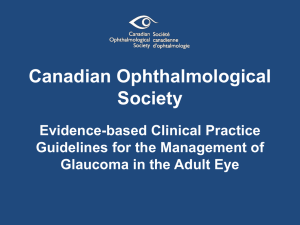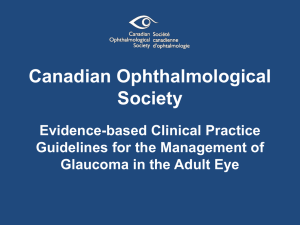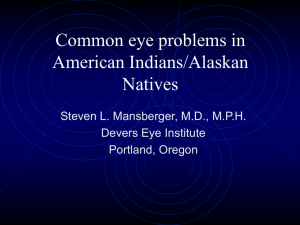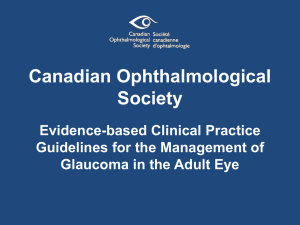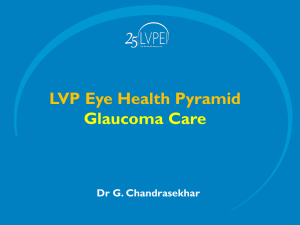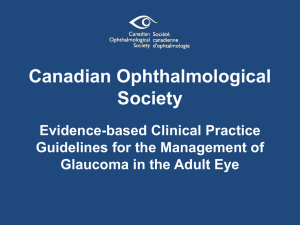Diagnosis and clinical exam - Canadian Ophthalmological Society
advertisement
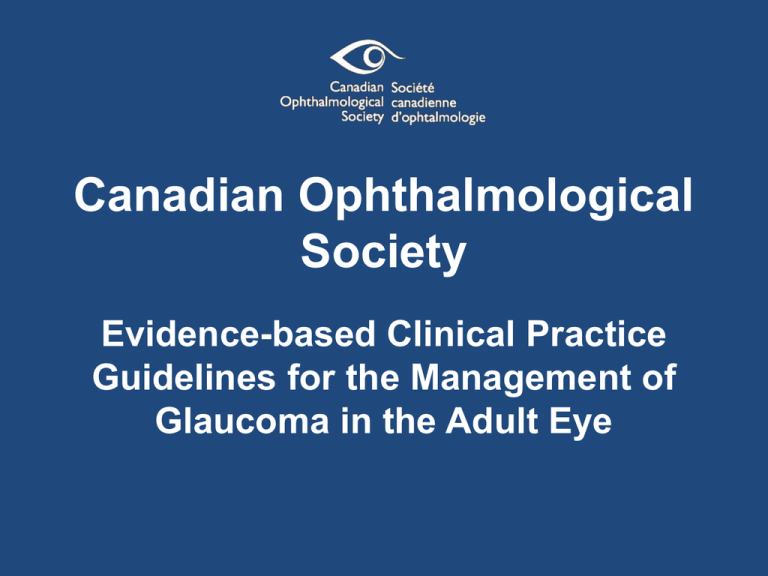
Canadian Ophthalmological Society Evidence-based Clinical Practice Guidelines for the Management of Glaucoma in the Adult Eye Diagnosis of Glaucoma Diagnosis of glaucoma • The essential elements of a comprehensive eye examination and patient history form the basis of an examination for glaucoma,1 with specific attention to: – – – – – – the evaluation of the optic nerve, potential risk factors for glaucoma, the possibility of secondary glaucomas, concomitant systemic diseases, medications, and subjective symptoms. 1. Canadian Ophthalmological Society Clinical Practice Guideline Expert Committee. Can J Ophthalmol 2007;42:39–45. Canadian Ophthalmological Society evidence-based clinical practice guidelines for the management of glaucoma in the adult eye. Can J Ophthalmol 2009;44(Suppl 1):S1S93. Essential elements of the comprehensive glaucoma eye examination Element History Criteria • Patient name, date of birth, gender, and race • Driving status • Vocation and avocations • Chief complaint, if any (e.g. any perceived visual handicap) • Current medication and allergies (ocular and systemic) • Ocular history • Medical history • Medical and ocular family history (including family history of glaucoma) • Directed review of systems Canadian Ophthalmological Society evidence-based clinical practice guidelines for the management of glaucoma in the adult eye. Can J Ophthalmol 2009;44(Suppl 1):S1S93. Essential elements of the comprehensive glaucoma eye examination (cont’d) Element Criteria Clinical • Best corrected distance visual acuity with refraction examination documented and • Pupillary reaction, relative afferent pupillary defect investigations • Automated perimetry • Slit lamp examination of lids, lid margins, conjunctiva, cornea, anterior chamber (clarity and depth), lens • IOP and time of measurement • CCT • Gonioscopy • Dilated examination of: Lens Biomicroscopy of ONH and RNF including objective documentation such as optic disc imaging Fundus Canadian Ophthalmological Society evidence-based clinical practice guidelines for the management of glaucoma in the adult eye. Can J Ophthalmol 2009;44(Suppl 1):S1S93. Essential elements of the comprehensive glaucoma eye examination (cont’d) Element Criteria Discussion • Discussion of findings with appropriate correction with patient and mitigating strategy • Counselling with respect to QOL issues (e.g. low vision rehabilitation, adherence) • Follow-up recommendation Canadian Ophthalmological Society evidence-based clinical practice guidelines for the management of glaucoma in the adult eye. Can J Ophthalmol 2009;44(Suppl 1):S1S93. Systemic diseases and medications Recommendation Specific information related to concomitant systemic diseases and medications that may influence glaucoma treatment should be sought [Consensus]. Canadian Ophthalmological Society evidence-based clinical practice guidelines for the management of glaucoma in the adult eye. Can J Ophthalmol 2009;44(Suppl 1):S1S93. Optic disc cupping — non-glaucomatous causes Recommendation When considering the diagnosis of glaucoma, particularly when IOPs are in the normal range, specific inquiry should be made with regard to antecedent events that could have resulted in cupping and/or optic atrophy [Level 41]. 1. Greenfield DS, et al. Ophthalmology 1998;105:1866–74. Canadian Ophthalmological Society evidence-based clinical practice guidelines for the management of glaucoma in the adult eye. Can J Ophthalmol 2009;44(Suppl 1):S1S93. Risk Factors for Glaucoma Risk factors and signs for presence of open-angle glaucoma with level 1 evidence Ocular risk factors and signs • IOP • Elevated baseline IOP • Optic disc • Deviation from the ISNT rule* • Increased optic disc diameter • Parapapillary atrophy • • • • • • Disc hemorrhage PXF Thinner CCT Pigment dispersion Myopia Decreased ocular perfusion pressure Non-ocular risk factors • Increasing age • African descent • Hispanic ancestry • Family history • Genetics • • • • • Myocillin Optineurin Apolipoprotein Migraine Corticosteroids *ISNT rule; majority of normal optic discs with neuroretinal rims with descending order of thickness—inferior, superior, nasal, temporal. Canadian Ophthalmological Society evidence-based clinical practice guidelines for the management of glaucoma in the adult eye. Can J Ophthalmol 2009;44(Suppl 1):S1S93. Appendix B: Moderate glaucomatous optic neuropathy • Localised loss of both inferior and superior neuroretinal rim • A classic inferior notch (small arrow heads) • Nerve fibre layer defect in both superior and inferior arcuate area (large arrow heads) Copyright © 2008 SEAGIG, Sydney. Reproduced with permission from Asia Pacific Glaucoma Guidelines, 2nd ed. Hong Kong: Scientific Communications, 208:1-117. Canadian Ophthalmological Society evidence-based clinical practice guidelines for the management of glaucoma in the adult eye. Can J Appendix B: Advanced glaucomatous optic neuropathy • Neuroretinal rim thinning • The cup extends to the disc rim • Circumlinear blood vessel baring • Bayoneting of the blood vessels • Parapapillary atrophy Copyright © 2008 SEAGIG, Sydney. Reproduced with permission from Asia Pacific Glaucoma Guidelines, 2nd ed. Hong Kong: Scientific Communications, 208:1-117. Copyright © 2008 SEAGIG, Sydney. Canadian Ophthalmological Society evidence-based clinical practice guidelines for the management of glaucoma in the adult eye. Can J Ophthalmol 2009;44(Suppl 1):S1S93. Appendix B: Disc hemorrhage • • • • Splinter, superficial flameshaped, hemorrhage at disc margin (large arrow head) Localised nerve fibre defect at corresponding area (small arrow heads) Laminar dots are visible A deep notch at the inferotemporal neuroretinal rim with broad nerve fibre defect (dark arrow heads) Copyright © 2008 SEAGIG, Sydney. Reproduced with permission from Asia Pacific Glaucoma Guidelines, 2nd ed. Hong Kong: Scientific Communications, 208:1-117. Canadian Ophthalmological Society evidence-based clinical practice guidelines for the management of glaucoma in the adult eye. Can J Ophthalmol 2009;44(Suppl 1):S1S93. Risk factors and signs for conversion of ocular hypertension to glaucoma with Level 1 evidence Ocular risk factors and signs • IOP Higher baseline IOP • Optic disc Large cup-to-disc ratio Disc hemorrhage • Thinner CCT • Myopia • Increased pattern standard deviation Non-ocular risk factors • • • Increasing age African descent Family history Canadian Ophthalmological Society evidence-based clinical practice guidelines for the management of glaucoma in the adult eye. Can J Ophthalmol 2009;44(Suppl 1):S1S93. Risk factor assessment and management decisions Recommendation Risk factor assessment should be undertaken to facilitate management decisions related to the initiation and augmentation of ocular hypotensive therapy [Consensus]. Canadian Ophthalmological Society evidence-based clinical practice guidelines for the management of glaucoma in the adult eye. Can J Ophthalmol 2009;44(Suppl 1):S1S93. Clinical Examination Eye examination for glaucoma — essential components Recommendation The essential features of the clinical examination for glaucoma should include visual acuity, assessment for relative afferent pupillary defect, IOP (as well as method and time of measurement), CCT, gonioscopy, dilated optic disc and fundus evaluation, and VF testing [Consensus]. Canadian Ophthalmological Society evidence-based clinical practice guidelines for the management of glaucoma in the adult eye. Can J Ophthalmol 2009;44(Suppl 1):S1S93. Sample Glaucoma Referral Letter Sample glaucoma referral letter Canadian Ophthalmological Society evidence-based clinical practice guidelines for the management of glaucoma in the adult eye. Can J Ophthalmol 2009;44(Suppl 1):S1S93.
